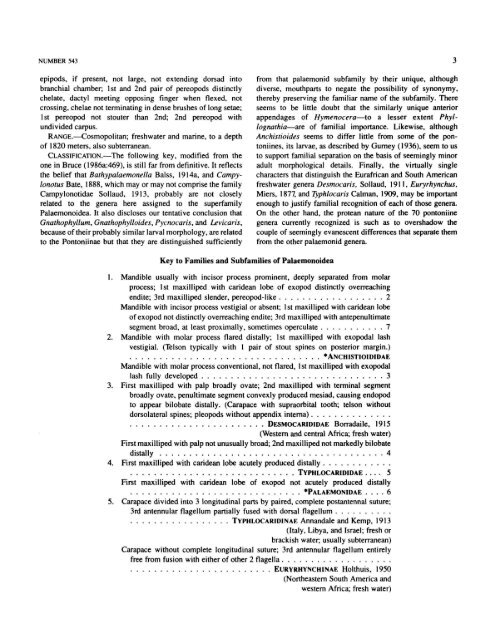SMITHSONIAN CONTRIBUTIONS TO ZOOLOGY • NUMBER 543 ...
SMITHSONIAN CONTRIBUTIONS TO ZOOLOGY • NUMBER 543 ...
SMITHSONIAN CONTRIBUTIONS TO ZOOLOGY • NUMBER 543 ...
Create successful ePaper yourself
Turn your PDF publications into a flip-book with our unique Google optimized e-Paper software.
<strong>NUMBER</strong> <strong>543</strong><br />
epipods, if present, not large, not extending dorsad into<br />
branchial chamber; 1st and 2nd pair of pereopods distinctly<br />
chelate, dactyl meeting opposing finger when flexed, not<br />
crossing, chelae not terminating in dense brushes of long setae;<br />
1st pereopod not stouter than 2nd; 2nd pereopod with<br />
undivided carpus.<br />
RANGE.—Cosmopolitan; freshwater and marine, to a depth<br />
of 1820 meters, also subterranean.<br />
CLASSIFICATION.—The following key, modified from the<br />
one in Bruce (1986a:469), is still far from definitive. It reflects<br />
the belief that Bathypalaemonella Balss, 1914a, and Campylonotus<br />
Bate, 1888, which may or may not comprise the family<br />
Campylonotidae Sollaud, 1913, probably are not closely<br />
related to the genera here assigned to the superfamily<br />
Palaemonoidea. It also discloses our tentative conclusion that<br />
Gnathophyllum, Gnathophylloides, Pycnocaris, and Levicaris,<br />
because of their probably similar larval morphology, are related<br />
to the Pontoniinae but that they are distinguished sufficiently<br />
Key to Families and Subfamilies of Palaemonoidea<br />
from that palaemonid subfamily by their unique, although<br />
diverse, mouthparts to negate the possibility of synonymy,<br />
thereby preserving the familiar name of the subfamily. There<br />
seems to be little doubt that the similarly unique anterior<br />
appendages of Hymenocera—to a lesser extent Phyllognathia—are<br />
of familial importance. Likewise, although<br />
Anchistioides seems to differ little from some of the pontoniines,<br />
its larvae, as described by Gurney (1936), seem to us<br />
to support familial separation on the basis of seemingly minor<br />
adult morphological details. Finally, the virtually single<br />
characters that distinguish the Eurafrican and South American<br />
freshwater genera Desmocaris, Sollaud, 1911, Euryrhynchus,<br />
Miers, 1877, and Typhlocaris Caiman, 1909, may be important<br />
enough to justify familial recognition of each of those genera.<br />
On the other hand, the protean nature of the 70 pontoniine<br />
genera currently recognized is such as to overshadow the<br />
couple of seemingly evanescent differences that separate them<br />
from the other palaemonid genera.<br />
1. Mandible usually with incisor process prominent, deeply separated from molar<br />
process; 1st maxilliped with caridean lobe of exopod distinctly overreaching<br />
endite; 3rd maxilliped slender, pereopod-like 2<br />
Mandible with incisor process vestigial or absent; 1st maxilliped with caridean lobe<br />
of exopod not distinctly overreaching endite; 3rd maxilliped with antepenultimate<br />
segment broad, at least proximally, sometimes operculate 7<br />
2. Mandible with molar process flared distally; 1st maxilliped with exopodal lash<br />
vestigial. (Telson typically with 1 pair of stout spines on posterior margin.)<br />
*ANCHISTIOIDIDAE<br />
Mandible with molar process conventional, not flared, 1st maxilliped with exopodal<br />
lash fully developed 3<br />
3. First maxilliped with palp broadly ovate; 2nd maxiiliped with terminal segment<br />
broadly ovate, penultimate segment convexly produced mesiad, causing endopod<br />
to appear bilobate distally. (Carapace with supraorbital tooth; telson without<br />
dorsolateral spines; pleopods without appendix interna)<br />
DESMOCARIDIDAE Borradaile, 1915<br />
(Western and central Africa; fresh water)<br />
First maxilliped with palp not unusually broad; 2nd maxilliped not markedly bilobate<br />
distally 4<br />
4. First maxilliped with caridean lobe acutely produced distally<br />
TYPHLOCARIDIDAE 5<br />
First maxilliped with caridean lobe of exopod not acutely produced distally<br />
*PALAEMONIDAE .... 6<br />
5. Carapace divided into 3 longitudinal parts by paired, complete postantennal suture;<br />
3rd antennular flagellum partially fused with dorsal flagellum<br />
TYPHLOCARIDINAE Annandale and Kemp, 1913<br />
(Italy, Libya, and Israel; fresh or<br />
brackish water, usually subterranean)<br />
Carapace without complete longitudinal suture; 3rd antennular flagellum entirely<br />
free from fusion with either of other 2 flagella<br />
EURYRHYNCHINAE Holthuis, 1950<br />
(Northeastern South America and<br />
western Africa; fresh water)

















